|
Chapter 43 -
Looking for the First Time
Here is what the Ancient Egyptians said about the First Time,
Zep
Tepi, when the gods ruled in their country:
they said it was a
golden age1 during which the waters of the abyss receded, the
primordial darkness was banished, and humanity, emerging into the
light, was offered the gifts of civilization.2
They spoke also of intermediaries between gods and men - the Urshu,
a category of lesser divinities whose title meant 'the Watchers'.3
And they preserved
particularly vivid recollections of the gods themselves, puissant
and beautiful beings called the Neteru who lived on earth with
humankind and exercised their sovereignty from Heliopolis and other
sanctuaries up and down the Nile. Some of these Neteru were male and
some female but all possessed a range of supernatural powers which
included the ability to appear, at will, as men or women, or as
animals, birds, reptiles, trees or plants.
Paradoxically, their
words and deeds seem to have reflected human passions and
preoccupations. Likewise, although they were portrayed as stronger
and more intelligent than humans, it was believed that they could
grow sick - or even die, or be killed - under certain circumstances.4
1
Myth and Symbol in Ancient Egypt, pp. 263-4; see also Nicolas Grimal,
A History of Ancient Egypt, Blackwell, Cambridge, 1992, p. 46.
2 New
Larousse Encyclopaedia of Mythology, p. 16.
3
The Gods of the Egyptians, volume I, pp. 84, 161; The Ancient
Egyptian Pyramid Texts, pp. 124, 308.
4 Osiris And The Egyptian
Resurrection, volume I, p. 352.
Records of prehistory
Archaeologists are adamant that the epoch of the gods, which the
Ancient Egyptians, called the First Time, is nothing more than a
myth. The Ancient Egyptians, however, who may have been better
informed about their past than we are, did not share this view.
The
historical records they kept in their most venerable temples
included comprehensive lists of all the kings of Egypt: lists naming
every pharaoh of every dynasty recognized by scholars today.5 Some
of these lists went even further, reaching back beyond the
historical horizon of the First Dynasty into the uncharted depths of
a remote and profound antiquity.
5
Michael Hoffman, Egypt before the Pharaohs, Michael O'Mara Books,
1991, pp. 12-13; Archaic Egypt, pp. 21-3; The Encyclopaedia of
Ancient Egypt, pp. 138-9.
Two lists of kings in this category have survived the ravages of the
ages and, having been exported from Egypt, are now preserved in
European
museums. We shall consider these lists in more detail later in this
chapter. They are known respectively as the Palermo Stone (dating
from the Fifth Dynasty - around the twenty-fifth century BC), and the
Turin Papyrus, a nineteenth Dynasty temple document inscribed in a
cursive form of hieroglyphs known as hieratic and dated to the
thirteenth century BC.6
In addition, we have the testimony of a Heliopolitan priest named
Manetho. In the third century BC he compiled a comprehensive and
widely respected history of Egypt which provided extensive king
lists for the entire dynastic period.
Like the Turin Papyrus and the
Palermo Stone, Manetho's history also reached much further back into
the past to speak of a distant epoch when gods had ruled in the Nile
Valley.
Manetho's complete text has not come down to us, although copies of
it seem to have been in circulation as late as the ninth century
AD.7 Fortuitously, however, fragments of it were preserved in the
writings of the Jewish chronicler Josephus (AD 60) and of Christian
writers such as Africanus (AD 300), Eusebius (AD 340) and George Syncellus (AD 800).8
These fragments, in the words of the late
Professor Michael Hoffman of the University of South Carolina,
provide the 'framework for modern approaches to the study of Egypt's
past'.9
This is quite true.10 Nevertheless, Egyptologists are prepared to
use Manetho only as a source for the historical (dynastic) period
and repudiate the strange insights he provides into prehistory when
he speaks of the remote golden age of the First Time.
-
Why should we
be so selective in our reliance on Manetho?
-
What is the logic of
accepting thirty 'historical' dynasties from him and rejecting all
that he has to say about earlier epochs?
-
Moreover, since we know
that his chronology for the historical period has been vindicated by
archaeology,11 isn't it a bit premature for us to assume that his
pre-dynastic chronology is wrong because excavations have not yet
turned up evidence confirming it?12
6
Egypt before the Pharaohs, pp. 12-13; The Encyclopaedia of Ancient
Egypt, pp. 200,
268.
7 Egypt before the Pharaohs, p. 12.
8
Archaic Egypt, p. 23; Manetho, (trans. W. G. Waddell), William
Heinemann, London, 1940, Introduction pp. xvi-xvii.
9 Egypt before
the Pharaohs, p. 11.
10 Ibid., p. 11-13; Archaic Egypt, pp. 5, 23.
11 See, for example, Egypt before the Pharaohs, pp. 11-13.
12
This is a particularly important point to remember in a discipline
like Egyptology where so much of the record of the past has been
lost through looting, the ravages of time, and the activities of
archaeologists and treasure hunters. Besides, vast numbers of
Ancient Egyptian sites have not been investigated at all, and many
more may lie out of our reach beneath the millennial silt of the
Nile Delta (or beneath the suburbs of Cairo for that matter), and
even at well-studied locations such as the Giza necropolis there are
huge areas - the bedrock beneath the Sphinx for example - which still
await the attentions of the excavator.
Gods, Demigods and Spirits of the Dead
If we are to allow Manetho to speak for himself, we have no choice
but to turn to the texts in which the fragments of his work are
preserved. One of the most important of these is the Armenian
version of the Chronica of Eusebius.
It begins by informing us that
it is extracted,
'from the Egyptian History of Manetho,
who composed his account in three books. These deal with the
Gods, the Demigods, the Spirits of the Dead and the mortal kings
who ruled Egypt ...'13
Citing Manetho directly, Eusebius begins by reeling off a list of
the gods which consists, essentially, of the familiar Ennead of Heliopolis
- Ra, Osiris, Isis, Horus, Set, and so on:14
These were the first to hold sway in
Egypt. Thereafter, the kingship passed from one to another in
unbroken succession ... through 13,900 years - ...
After the Gods, Demigods reigned for 1255 years; and again
another line of kings held sway for 1817 years; then came thirty
more kings, reigning for 1790 years; and then again ten kings
ruling for 350 years. There followed the rule of the Spirits of
the Dead ... for 5813 years ...'15
The total of all these periods adds up to 24,925 years and takes us
far beyond the biblical date for the creation of the world (some
time in the fifth millennium BC16). Because it suggested that
biblical chronology was wrong, this created difficulties for
Eusebius, a staunchly Christian commentator. But, after a moment's
thought, he overcame the problem in an inspired way:
'The year I take to be a lunar one,
consisting, that is, of 30 days: what we now call a month the
Egyptians used formerly to style a year ...'17
Of course they did no such thing.18 By means of this sleight of
hand, however, Eusebius and others succeeded in boiling down Manetho's grand pre-dynastic span of almost 25,000 years into a
sanitized dollop a bit over 2000 years which fits comfortably into
the 2242 years orthodox biblical chronology allows between Adam and
the Flood.19
A different technique for downplaying the disturbing chronological
implications of Manetho's evidence is employed by the monk George Syncellus (c. AD 800). This commentator, who relies entirely on
invective, writes,
'Manetho, chief priest of the
accursed temples of Egypt [tells us] of gods who never existed.
These, he says, reigned for 11,895 years ...'20
13 Manetho, p. 3.
14 Ibid., pp. 3-5.
15 Ibid., p. 5.
16 Encyclopaedia Britannica, 1991, 12:214-15.
17 Manetho, p. 5.
18
There is absolutely no evidence that the Ancient Egyptians ever
confused years and months, or styled one as the other; ibid, p. 4,
note 2.
19 Ibid., p. 7. 20 Ibid., p. 15.
Several other curious and contradictory numbers crop up in the
fragments. In particular, Manetho is repeatedly said to have given
the
enormous figure of 36,525 years for the entire duration of the
civilization of Egypt from the time of the gods down to the end of
the thirtieth (and last) dynasty of mortal kings.21 This figure of
course, incorporates the
365.25 days of the Sothic year (the interval between two consecutive
heliacal risings of Sirius, as described in the last chapter). More
likely by design than by accident, it also represents 25 cycles of
1460 Sothic years, and 25 cycles of 1461 calendar years (since the
ancient Egyptian civil calendar was constructed around a 'vague
year' of 365 days exactly).22
21 Ibid., p. 231; see also The Splendour that was Egypt, p. 12.
22
Like the Maya, (see Part III), the Ancient Egyptians made use for
administrative purposes of a civil calendar year (or vague year) of
365 days exactly. See Skywatchers of Ancient Mexico, p. 151, for
further details on the Maya vague year. The Ancient Egyptian civil
calendar year was geared to the Sothic year so that both would
coincide on the same day/month position once every 1461 calendar
years.
What, if anything, does all this mean? It's hard to be sure. Out of
the welter of numbers and interpretations, however, there is one
aspect of Manetho's original message that comes through loud and
clear. Irrespective of everything we have been taught about the
orderly progress of history, what he seems to be telling us is that
civilized beings (either gods or men) were present in Egypt for an
immensely long period before the advent of the First Dynasty around
3100 BC.
Diodorus Siculus and Herodotus
In this assertion, Manetho finds much support among classical
writers.
In the first century BC, for example, the Greek historian Diodorus
Siculus visited Egypt. He is rightly described by C.H. Oldfather,
his most recent translator, as 'an uncritical compiler who used good
sources and reproduced them faithfully'.23 In plain English, what
this means is that Diodorus did not try to impose his prejudices and
preconceptions on the material he collected. He is therefore
particularly valuable to us because his informants included Egyptian
priests whom he questioned about the mysterious past of their
country.
This is what they told him:
'At first gods and heroes ruled Egypt for a little less than 18,000
years, the last of
the gods to rule being Horus, the son of Isis ... Mortals have been
kings of their
country, they say, for a little less than 5000 years ...24
Let us review these figures 'uncritically' and see what they add up
to. Diodorus was writing in the first century BC. If we journey back
from there for the 5000 years during which the 'mortal kings'
supposedly ruled, we get to around 5100 BC. If we go even further
back to the beginning of the age of 'gods and heroes', we find that
we have arrived at 23,100 BC, when the world was still firmly in the
grip of the last Ice Age.
23
Diodorus Siculus, translated by C.H. Oldfather, Harvard University
Press, 1989, jacket text.
24 Ibid., volume I, p. 157.
Long before Diodorus, Egypt was visited by another and more
illustrious Greek historian: the great Herodotus, who lived in the
fifth century BC. He too, it seems, consorted with priests and he
too managed to tune in to traditions that spoke of the presence of a
high civilization in the Nile Valley at some unspecified date in
remote antiquity.
Herodotus outlines these traditions of an immense
prehistoric period of Egyptian civilization in Book II of his
History. In the same document he also hands on to us, without
comment, a peculiar nugget of information which had originated with
the priests of Heliopolis:
During this time, they said, there were four occasions when the sun
rose out of his
wonted place - twice rising where he now sets, and twice setting where
he now
rises.25
What is this all about?
According to the French mathematician Schwaller de Lubicz, what
Herodotus is transmitting to us (perhaps unwittingly) is a veiled
and garbled reference to a period of time - that is, to the time that
it takes for sunrise on the vernal equinox to precess against the
stellar background through one and a half complete cycles of the
zodiac.26
25
The History, pp. 193-4. In the first century AD a similar tradition
was recorded by the Roman scholar Pomponious Mela: 'The Egyptians
pride themselves on being the most ancient people in the world. In
their authentic annals one may read that since they have been in
existence, the course of the stars has changed direction four times,
and that the sun has set twice in the part of the sky where it rises
today.' (Pomponious Mela, De Situ Orbis.)
26 Sacred Science, p. 87
As we have seen, the equinoctial sun spends roughly 2160 years in
each of the twelve zodiacal constellations. A full cycle of
precession of the equinoxes therefore takes almost 26,000 years to
complete (12 x 2160 years). It follows that one and a half cycles
takes nearly 39,000 years (18 x 2160 years).
In the time of Herodotus the sun on the vernal equinox rose due east
at dawn against the stellar background of Aries - at which moment the
constellation of Libra was 'in opposition', lying due west where the
sun would set twelve hours later. If we wind the clock of precession
back half a cycle, however - six houses of the zodiac or approximately
13,000 years - we find that the reverse configuration prevails: the
vernal sun now rises due east in Libra while Aries lies due west in
opposition. A further 13,000 years back, the situation reverses
itself once more, with the vernal sun rising again in Aries and with
Libra in opposition.
This takes us to 26,000 years before Herodotus.
If we then step back another 13,000 years, another half precessional
cycle, to 39,000 years before Herodotus, the vernal sunrise returns
to Libra, and Aries is again in opposition.
The point is this: with 39,000 years we have an expanse of time
during which the sun can be described as 'twice rising where he now
sets', i.e. in
Libra in the time of Herodotus (and again at 13,000 and at 39,000
years earlier), and as 'twice setting where he now rises', i.e. in
Aries in the time of Herodotus (and again at 13,000 and 39,000 years
earlier).27
27 As the following table makes clear:

If Schwaller's interpretation is correct - and there is
every reason to suppose it is - it suggests that the Greek historian's
priestly informants must have had access to accurate records of the precessional motion of the sun going back at least 39,000 years
before their own era.
The Turin Papyrus and the Palermo Stone
The figure of 39,000 years accords surprisingly closely with the
testimony of the Turin Papyrus (one of the two surviving Ancient
Egyptian king lists that extends back into prehistoric times before
the First Dynasty).
Originally in the collection of the king of Sardinia, the brittle
and crumbling 3000-year-old papyrus was sent in a box, without
packing, to its present home in the Museum of Turin. As any
schoolchild could have predicted, it arrived broken into countless
fragments. Scholars were obliged to work for years to piece together
and make sense of what remained, and they did a superb job.28
Nevertheless, more than half the contents of this precious record
proved impossible to reconstruct.29
What might we have learned about the First Time if the Turin Papyrus
had remained intact?
The surviving fragments are tantalizing. In one register, for
example, we read the names often Neteru with each name inscribed in
a cartouche (oblong enclosure) in much the same style adopted in
later periods for the historical kings of Egypt. The number of years
that each Neter was believed to have reigned was also given, but
most of these numbers are missing from the damaged document.30
In another column there appears a list of the mortal kings who ruled
in upper and lower Egypt after the gods but prior to the supposed
unification of the kingdom under Menes, the first pharaoh of the
First Dynasty, in 3100 BC.
From the surviving fragments it is possible to
372 establish that nine 'dynasties' of these pre-dynastic pharaohs
were mentioned, among which were 'the Venerables of Memphis', 'the Venerables of the North' and, lastly, the Shemsu Hor (the
Companions, or Followers, of Horus) who ruled until the time of
Menes.
The final two lines of the column, which seem to represent a
summing up or inventory, are particularly provocative. They read:
'... Venerables Shemsu-Hor, 13,420 years; Reigns before the
Shemsu-Hor, 23,200 years; Total 36,620 years'.31
The other king list that deals with prehistoric times is the Palermo
Stone, which does not take us as far back into the past as the Turin
Papyrus. The earliest of its surviving registers record the reigns
of 120 kings who ruled in upper and lower Egypt in the late
pre-dynastic period: the centuries immediately prior to the
country's unification in 3100 BC.32
Once again, however, we really
have no idea how much other information, perhaps relating to far
earlier periods, might originally have been inscribed on this
enigmatic slab of black basalt, because it, too, has not come down
to us intact. Since 1887 the largest single part has been preserved
in the Museum of Palermo in Sicily; a second piece is on display in
Egypt in the Cairo Museum; and a third much smaller fragment is in
the Petrie Collection at the University of London.33
These are
reckoned by archaeologists to have been broken out of the centre of
a monolith which would originally have measured about seven feet
long by two feet high (stood on its long side).34 Furthermore, as
one authority has observed:
It is quite possible - even probable
- that many more pieces of this
invaluable monument remain, if we only knew where to look. As it is
we are faced with the tantalising knowledge that a record of the
name of every king of the Archaic Period existed, together with
the number of years of his reign and the chief events which
occurred during his occupation of the throne. And these events
were compiled in the Fifth Dynasty, only about 700 years after
the Unification, so that the margin of error would in all
probability have been very small ...'35
The late Professor Walter Emery, whose words these are, was
naturally concerned about the absence of much-needed details
concerning the Archaic Period, 3200 BC to 2900 BC,36 the focus of
his own specialist interests. We should also spare a thought,
however, for what an intact
Palermo Stone might have told us about even earlier epochs, notably
Zep Tepi - the golden age of the gods.
28
See, for example, Sir A.H. Gardner, The Royal Cannon of Turin,
Griffith Institute, Oxford.
29 Archaic Egypt, p. 4.
30 For further
details, Sacred Science, p. 86.
31 Ibid., p. 86. See also Egyptian Mysteries, p. 68.
32 Archaic
Egypt, p. 5; Encyclopaedia of Ancient Egypt, p. 200.
33 Archaic
Egypt, p. 5; Encyclopaedia Britannica, 1991, 9:81.
34 Encyclopaedia
of Ancient Egypt, p. 200.
35 Archaic Egypt, p. 5.
36 Egypt to the End
of the Old Kingdom, p. 12.
The deeper we penetrate into the myths and memories of Egypt's long
past, and the closer we approach to the fabled First Time, the
stranger the landscapes that surround us become ... as we shall see.
Back to
Contents
Chapter 44 -
Gods of the First Time
According to Heliopolitan theology, the nine original gods who
appeared in Egypt in the First Time were Ra, Shu, Tefnut, Geb, Nut,
Osiris, Isis, Nepthys and Set.
The offspring of these deities
included well-known figures such as Horus and Anubis. In addition,
other companies of gods were recognized, notably at Memphis and Hermopolis, where there were important and very ancient cults
dedicated to Ptah and to Thoth.1
These First Time deities were all
in one sense or another gods of creation who had given shape to
chaos through their divine will. Out of that chaos they formed and
populated the sacred land of Egypt,2 wherein, for many thousands of
years, they ruled among men as divine pharaohs.3
What was 'chaos'?
The Heliopolitan priests who spoke to the Greek historian Diodorus
Siculus in the first century BC put forward the thought-provoking
suggestion that 'chaos' was a flood - identified by Diodorus with the
earth-destroying flood of Deucalion, the Greek Noah figure: 4
In general, they say that if in the flood which occurred in the time
of Deucalion most living things were destroyed, it is probable that
the inhabitants of southern Egypt survived rather than any others
... Or if, as some maintain, the destruction of living things was
complete and the earth then brought forth again new forms of
animals, nevertheless, even on such a supposition, the first genesis
of living things fittingly attaches to this country ...5
Why should Egypt have been so blessed?
Diodorus was told that it had
something to do with its geographical situation, with the great
exposure of its southern regions to the heat of the sun, and with
the vastly increased rainfall which the myths said the world had
experienced in the aftermath of the universal deluge:
'For when the moisture from the
abundant rains which fell among other peoples was mingled with
the intense heat which prevails in Egypt itself ... the air
became very well tempered for the first generation of all living
things ...'6
1
Kingship and the Gods, pp. 181-2; The Encyclopaedia of Ancient
Egypt, pp. 209, 264; Egyptian Myths, pp. 18-22. See also T. G. H.
James, An Introduction to Ancient Egypt, British Museum
Publications, London, 1979, p. 125ff.
2
Cyril Aldred, Akhenaton, Abacus, London, 1968, p. 25: 'It was
believed that the gods had ruled in Egypt after first making it
perfect.'
3
Kingship and the Gods, pp. 153-5; Egyptian Myths, pp. 18-22;
Egyptian Mysteries, pp. 8-11; New Larousse Encyclopaedia of
Mythology, pp. 10-28. 4 See Part IV.
5 Diodorus Siculus, volume I,
p. 37.
6 Ibid.
Curiously enough, Egypt does enjoy a special geographical situation:
as
is well known, the latitude and longitude lines which intersect just
beside the Great Pyramid (30° north and 31° east) cross more dry
land than any others.7
Curiously, too, at the end of the last Ice
Age, when millions of square miles of glaciation were melting in
northern Europe, when rising sea levels were flooding coastal areas
all around the globe, and when the huge volume of extra moisture
released into the atmosphere through the evaporation of the ice
fields was being dumped as rain, Egypt benefited for several
thousands of years from an exceptionally humid and fertile climate.8
It is not difficult to see how such a climate might indeed have been
remembered as 'well tempered for the first generation of all living
things'.
The question therefore has to be asked: whose information about the
past are we receiving from Diodorus, and is the apparently accurate
description of Egypt's lush climate at the end of the last Ice Age a
coincidence, or is an extremely ancient tradition being transmitted
to us here - a memory, perhaps, of the First Time?
7 Mystic Places, Time-Life Books,
1987, p. 62.
8 Early Hydraulic Civilization in
Egypt, p. 13; Egypt before the Pharaohs, pp. 27, 261.
Breath of the divine serpent
Ra was believed to have been the first king of the First Time and
ancient myths say that as long as he remained young and vigorous he
reigned peacefully.
The passing years took their toll on him,
however, and he is depicted at the end of his rule as an old,
wrinkled, stumbling man with a trembling mouth from which saliva
ceaselessly dribbles.9
Shu followed Ra as king on earth, but his reign was troubled by
plots and conflicts. Although he vanquished his enemies he was in
the end so ravaged by disease that even his most faithful followers
revolted against him: 'Weary of reigning, Shu abdicated in favour of
his son Geb and took refuge in the skies after a terrifying tempest
which lasted nine days ...'10
Geb, the third divine pharaoh, duly succeeded Shu to the throne. His
reign was also troubled and some of the myths describing what took
place reflect the odd idiom of the Pyramid Texts in which a
non-technical vocabulary seems to wrestle with complex technical and
scientific imagery.
For example, one particularly striking tradition
speaks of a 'golden box' in which Ra had deposited a number of
objects - described, respectively, as his 'rod' (or cane), a lock of
his hair, and his uraeus (a rearing cobra with its hood extended,
fashioned out of gold, which was worn on the royal head-dress).11
9 New Larousse Encyclopaedia of Mythology, p. 11.
10 Ibid., p.
13.
11 Ibid., pp. 14-15.
A powerful and dangerous talisman, this box, together with its
bizarre
contents, remained enclosed in a fortress on the 'eastern frontier'
of Egypt until a great many years after Ra's ascent to heaven. When
Geb came to power he ordered that it should be brought to him and
unsealed in his presence. In the instant that the box was opened a
bolt of fire (described as the 'breath of the divine serpent')
ushered from it, struck dead all Geb's companions and gravely burned
the god-king himself.12
It is tempting to wonder whether what we are confronted by here
might not be a garbled account of a malfunctioning man-made device:
a confused, awe-stricken recollection of a monstrous instrument
devised by the scientists of a lost civilization. Weight is added to
such extreme speculations when we remember that this is by no means
the only golden box in the ancient world that functioned like a
deadly and unpredictable machine.
It has a number of quite unmissable similarities to the Hebrews' enigmatic
Ark of the
Covenant (which also struck innocent people dead with bolts of fiery
energy, which also was 'overlaid round about with gold', and which
was said to have contained not only the two tablets of the Ten
Commandments but 'the golden pot that had manna, and Aaron's
rod.')13
A proper look at the implications of all these weird and wonderful
boxes (and of other 'technological' artifacts referred to in ancient
traditions) is beyond the scope of this book. For our purposes here
it is sufficient to note that a peculiar atmosphere of dangerous and
quasi-technological wizardry seems to surround many of the gods of
the Heliopolitan Ennead.
Isis, for example (wife and sister of Osiris and mother of Horus)
carries a strong whiff of the science lab. According to the Chester
Beatty Papyrus in the British Museum she was 'a clever woman ...
more intelligent than countless gods ... She was ignorant of nothing
in heaven and earth.'14
Renowned for her skilful use of witchcraft
and magic, Isis was particularly remembered by the Ancient Egyptians
as,
'strong of tongue', that is being in command of words of power
'which she knew with correct pronunciation, and halted not in her
speech, and was perfect both in giving the command and in saying the
word'.15
In short, she was believed, by means of her voice alone, to
be capable of bending reality and overriding the laws of physics.
These same powers, though perhaps in greater degree, were attributed
to the wisdom god Thoth who although not a member of the
Heliopolitan Ennead is recognized in the Turin Papyrus and other
ancient records as the sixth (or sometimes as the seventh) divine
pharaoh of Egypt.16
12 Ibid.
13
Hebrews 9:4. For details of the Ark's baleful powers see Graham
Hancock, The Sign and the Seal, Mandarin, London, 1993, Chapter 12,
p. 273ff.
14 Cited in Egyptian Myths, p. 44.
15
Sir E. A. Wallis Budge, Egyptian Magic, Kegan Paul, Trench, London,
1901, p. 5; The Gods of the Egyptians, volume II, p. 214.
16
New Larousse Encyclopaedia of Mythology, p. 27. If Set's usurpation
is included as a
reign, we have seven divine pharaohs up to and including Thoth
(i.e., Ra, Shu, Geb, Osiris, Set, Horus, Thoth).
Frequently represented on temple and tomb walls as an ibis, or an
ibis-headed man, Thoth was venerated as the regulative force
responsible for all heavenly calculations and annotations, as the
lord and multiplier of time, the inventor of the alphabet and the
patron of magic. He was particularly associated with astronomy,
mathematics, surveying and geometry, and was described as 'he who
reckons in heaven, the counter of the stars and the measurer of the
earth'.17
He was also regarded as a deity who understood the
mysteries of 'all that is hidden under the heavenly vault', and who
had the ability to bestow wisdom on selected individuals. It was
said that he had inscribed his knowledge in secret books and hidden
these about the earth, intending that they should be sought for by
future generations but found 'only by the worthy' - who were to use
their discoveries for the benefit of mankind.18
What stands out most clearly about Thoth, therefore, in addition to
his credentials as an ancient scientist, is his role as a benefactor
and civilizer.19 In this respect he closely resembles his
predecessor Osiris, the high god of the Pyramid Texts and the fourth
divine pharaoh of Egypt,
'whose name becometh Sah [Orion],
whose leg is long, and his stride extended, the President of the
Land of the South ...'20
Osiris and the Lords of Eternity
Occasionally referred to in the texts as a neb tem, or
'universal
master',21 Osiris is depicted as human but also superhuman,
suffering but at the same time commanding.
Moreover, he expresses
his essential dualism by ruling m heaven (as the constellation of
Orion) and on earth as a king among men.
Like Viracocha in the Andes
and Quetzalcoatl in Central America, his ways are subtle and
mysterious. Like them, he is exceptionally tall and always depicted
wearing the curved beard of divinity.22
And like them too, although
he has supernatural powers at his
disposal, he avoids the use of force wherever possible.23
17
The Gods of the Egyptians, volume I, p. 400; Garth Fowden, The
Egyptian Hermes, Cambridge University Press, 1987, pp. 22-3. see
also From Fetish to God in Ancient Egypt, pp. 121-2; Egyptian Magic,
pp. 128-9; New Larousse Encyclopaedia of Mythology, pp. 27-8.
18
Manetho, quoted by the neo-Platonist Iamblichus. See Peter
Lemesurier, The Great Pyramid Decoded, Element Books, 1989, p. 15;
The Egyptian Hermes, p. 33.
19
See, for example, Diodorus Siculus, volume I, p. 53, where Thoth
(under his Greek name of Hermes) is described as being 'endowed with
unusual ingenuity for devising things capable of improving the
social life of man'.
20 Osiris and the Egyptian Resurrection, volume
II, p. 307.
21
Myth and Symbol in Ancient Egypt, p. 179; New Larousse Encyclopaedia
of Mythology,
p. 16.
22
New Larousse Encyclopaedia of Mythology, pp. 9-10, 16; Encyclopaedia
of Ancient Egypt, p. 44; The Gods of the Egyptians, volume II, pp.
130-1; From Fetish to God in
Ancient Egypt, p. 190; Myth and Symbol in Ancient Egypt, p. 230.
We saw in Chapter Sixteen that Quetzalcoatl, the god-king of the
Mexicans, was believed to have departed from Central America by sea,
sailing away on a raft of serpents. It is therefore hard to avoid a
sense of déjà vu when we read in the Egyptian Book of the Dead that
the abode of Osiris also 'rested on water' and had walls made of 'living serpents'.24 At the very least, the convergence of symbolism
linking these two gods and two far-flung regions is striking.
There are other obvious parallels as well.
The central details of the story of Osiris have been recounted in
earlier chapters and we need not go over them again. The reader will
not have forgotten that this god - once again like Quetzalcoatl and
Viracocha - was remembered principally as a benefactor of mankind, as
a bringer of enlightenment and as a great civilizing leader.25
He
was credited, for example, with having abolished cannibalism and was
said to have introduced the Egyptians to agriculture - in particular
to the cultivation of wheat and barley - and to have taught them the
art of fashioning agricultural implements.
Since he had an especial
liking for fine wines (the myths do not say where he acquired this
taste), he made a point of 'teaching mankind the culture of the
vine, as well as the way to harvest the grape and to store the wine
...'26 In addition to the gifts of good living he brought to his
subjects, Osiris helped to wean them 'from their miserable and
barbarous manners' by providing them with a code of laws and
inaugurating the cult of the gods in Egypt.27
When he had set everything in order, he handed over the control of
the kingdom to Isis, quit Egypt for many years, and roamed about the
world with the sole intention, Diodorus Siculus was told,
of visiting all the inhabited earth and teaching the race of men how
to cultivate the vine and sow wheat and barley; for he supposed that
if he made men give up their savagery and adopt a gentle manner of
life he would receive immortal honours because of the magnitude of
his benefactions ...28
Osiris travelled first to Ethiopia, where he taught tillage and
husbandry to the primitive hunter-gatherers he encountered.
He also
undertook a number of large-scale engineering and hydraulics works:
'He built canals, with flood gates
and regulators ... he raised the river banks and took
precautions to prevent the Nile from overflowing ...'29
Later he made his way to Arabia
and thence to India, where he established many cities. Moving on
to Thrace he killed a barbarian king for refusing to adopt his
system of government. This was out of character; in general,
Osiris was remembered by the Egyptians for having forced no man
to carry out his instructions, but by means of gentle persuasion
and an appeal to their reason he succeeded in inducing them to
practice what he preached. Many of his wise counsels were
imparted to his listeners in hymns and songs, which were sung to
the accompaniment of instruments of music.' 30
Once again the parallels with Quetzalcoatl and Viracocha are hard to
avoid.
During a time of darkness and chaos - quite possibly linked to
a flood - a bearded god, or man, materializes in Egypt (or Bolivia, or
Mexico). He is equipped with a wealth of practical and scientific
skills, of the kind associated with mature and highly developed
civilizations, which he uses unselfishly for the benefit of
humanity.
He is instinctively gentle but capable of great firmness
when necessary. He is motivated by a strong sense of purpose and,
after establishing his headquarters at Heliopolis (or Tiahuanaco, or
Teotihuacan), he sets forth with a select band of companions to
impose order and to reinstate the lost balance of the world.31
23 Osiris and the Egyptian Resurrection, volume I, p. 2.
24 Chapter CXXV, cited in ibid., volume II, p. 81.
25
See Parts II and III for Quetzalcoatl and Viracocha. A good summary
of Osiris's civilizing attributes is the New Larousse Encyclopaedia
of Mythology, p. 16. See also Diodorus Siculus, pp. 47-9; Osiris and
the Egyptian Resurrection, volume I, pp. 1-12.
26 Diodorus Siculus,
p. 53.
27 Ibid.; Osiris and the Egyptian Resurrection, volume I, p.
2.
28 Diodorus Siculus, p. 55.
29 Osiris and the Egyptian
Resurrection, volume I, p. 11.
30 Ibid., p. 2.
31
Ibid., 2-11. For Quetzalcoatl and Viracocha see Parts II and III.
Interestingly enough, Osiris was said to have been accompanied on
his civilizing mission by two 'openers of the way': (Diodorus
Siculus page 57), 'Anubis and Macedo, Anubis wearing a dog's skin
and Macedo the fore-parts of a wolf ...'
Leaving aside for the present the issue of whether we are dealing
here with gods or men, with figments of the primitive imagination or
with flesh-and-blood beings, the fact remains that the myths always
speak of a company of civilizers: Viracocha has his 'companions', as
have both Quetzalcoatl and Osiris.
Sometimes there are fierce
internal conflicts within these groups, and perhaps struggles for
power: the battles between Seth and Horus, and between
Tezcatlipoca
and Quetzalcoatl are obvious examples. Moreover, whether the
mythical events unfold in Central America, or in the Andes, or in
Egypt, the upshot is also always pretty much the same: the civilizer
is eventually plotted against and either driven out or killed.
The myths say that Quetzalcoatl and Viracocha never came back
(although, as we have seen, their return to the Americas was
expected at the time of the Spanish conquest). Osiris, on the other
hand, did come back. Although he was murdered by Set soon after the
completion of his worldwide mission to make men 'give up their
savagery', he won eternal life through his resurrection in the
constellation of Orion as the all-powerful god of the dead.
Thereafter, judging souls and providing an immortal example of
responsible and benevolent kingship, he dominated the religion (and
the culture) of Ancient Egypt for the entire span of its known
history.
Serene stability
Who can guess what the civilizations of the Andes and of Mexico
might have achieved if they too had benefited from such powerful
symbolic continuity.
In this respect, however, Egypt is unique.
Indeed, although the Pyramid Texts and other archaic sources
recognize a period of disruption and attempted usurpation by Set
(and his seventy-two 'precessional' conspirators), they also depict
the transition to the reigns of Horus, Thoth and the later divine
pharaohs as being relatively smooth and inevitable.
This transition was mimicked, through thousands of years, by the
mortal kings of Egypt. From the beginning to the end, they saw
themselves as the lineal descendants and living representatives of
Horus, son of Osiris. As generation succeeded generation, it was
supposed that each deceased pharaoh was reborn in the sky as 'an
Osiris' and that each successor to the throne became a 'Horus'.32
This simple, refined, and stable scheme was already fully evolved
and in place at the beginning of the First Dynasty - around 3100 BC.33
Scholars accept this; the majority also accept that what we are
dealing with here is a highly developed and sophisticated
religion.34 Strangely, very few Egyptologists or archaeologists have
questioned where and when this religion took shape.
Is it not to defy logic to suppose that well-rounded social and
metaphysical ideas like those of the Osiris cult sprung up fully
formed in 3100 BC, or that they could have taken such perfect shape
in the 300 years which Egyptologists sometimes grudgingly allow for
them to have done so?35
There must have been a far longer period of
development than that, spread over several thousands rather than
several hundreds of years. Moreover, as we have seen, every
surviving record in which the Ancient Egyptians speak directly about
their past asserts that their civilization was a legacy of 'the
gods' who were 'the first to hold sway in Egypt'.36
The records are not internally consistent: some attribute much
greater antiquity to the civilization of Egypt than others. All,
however, clearly and firmly direct our attention to an epoch far,
far in the past - anything from 8000 to almost 40,000 years before the
foundation of the First Dynasty.
Archaeologists insist that no material artefacts have ever been
found in Egypt to suggest that an evolved civilization existed at
such early dates, but this is not strictly true. As we saw in Part
VI, a handful of objects and structures exist which have not yet
been conclusively dated by any
scientific means.
32
Osiris and the Egyptian Resurrection, volume II, p. 273. See also in
general, The Ancient Egyptian Pyramid Texts.
33 Archaic Egypt, p.
122; Myth and Symbol in Ancient Egypt, p. 98.
34 See, in general,
Kingship and the Gods; Osiris and the Egyptian Resurrection; The
Gods of the Egyptians.
35 Archaic Egypt, p. 38.
36 Manetho, p. 5.
The ancient city of Abydos conceals one of the most extraordinary of
these undatable enigmas ...
Back to
Contents
Chapter 45
-
The Works of Men and Gods
Among the numberless ruined temples of Ancient Egypt, there is one
that is unique not only for its marvellous state of preservation,
which (rare indeed!) includes an intact roof, but for the fine
quality of the many acres of beautiful reliefs that decorate its
towering walls.
Located at Abydos, eight miles west of the present
course of the Nile, this is the Temple of Seti I, a monarch of the
illustrious nineteenth Dynasty, who ruled from 1306-1290 BC.1
Seti is known primarily as the father of a famous son: Ramesses II
(1290-1224 BC), the pharaoh of the biblical Exodus.2 In his own
right, however, he was a major historical figure who conducted
extensive military campaigns outside Egypt's borders, who was
responsible for the construction of several fine buildings and who
carefully and conscientiously refurbished and restored many older
ones.3
His temple at Abydos, which was known evocatively as
'The
House of Millions of Years', was dedicated to Osiris,4 the
'Lord of
Eternity', of whom it was said in the Pyramid Texts:
You have gone, but you will return, you have slept, but you will
awake, you have died, but you will live ... Betake yourself to the
waterway, fare upstream ... travel about Abydos in this spirit-form
of yours which the gods commanded to belong to you.5
1 Atlas of Ancient Egypt, p. 36.
2
Dates from Atlas of Ancient Egypt. For further data on Ramesses II
as the pharaoh of the exodus see Profuses K. A. Kitchen, Pharaoh
Triumphant: The Life and Times of Ramesses II, Aris and Phillips,
Warminster, 1982, pp. 70-1.
3 See, for example, A Biographical
Dictionary of Ancient Egypt, pp. 135-7.
4 Traveller's Key to Ancient
Egypt, p. 384.
5 The Ancient Egyptian Pyramid Texts, pp. 285, 253.
Atef Crown
It was eight in the morning, a bright, fresh hour in these
latitudes, when I entered the hushed gloom of the Temple of Seti I.
Sections of its walls were floor-lit by low-wattage electric bulbs;
otherwise the only illumination was that which the pharaoh's
architects had originally planned: a few isolated shafts of sunlight
that penetrated through slits in the outer masonry like beams of
divine radiance.
Hovering among the motes of dust dancing in those
beams, and infiltrating the heavy stillness of the air amid the
great columns that held up the roof of the Hypostyle
Hall, it was easy to imagine that the spirit-form of Osiris could
still be present. Indeed, this was more than just imagination
because Osiris was physically present in the astonishing symphony of
reliefs that adorned the walls - reliefs that depicted the once and
future civilizer-king in his role as god of the dead, enthroned and
attended by Isis, his beautiful and mysterious sister.
In these scenes Osiris wore a variety of different and elaborate
crowns which I studied closely as I walked from relief to relief.
Crowns similar to these in many respects had been important parts of
the wardrobe of all the pharaohs of Ancient Egypt, at least on the
evidence of reliefs depicting them.
Strangely, however, in all the
years of intensive excavations, archaeologists had not found a
single example of a royal crown, or a small part of one, let alone a
specimen of the convoluted ceremonial headdresses associated with
the gods of the First Time.6
Of particular interest was the Atef crown. Incorporating the uraeus,
the royal serpent symbol (which in Mexico was a rattlesnake but in
Egypt was a hooded cobra poised to strike), the central core of this
strange contraption was recognizable as an example of the hedjet,
the white skittle-shaped war helmet of upper Egypt (again known only
from reliefs).
Rearing up on either side of this core were what
seemed to be two thin leaves of metal, and at the front was an
attached device, consisting of two wavy blades, which scholars
normally describe as a pair of rams' horns.7
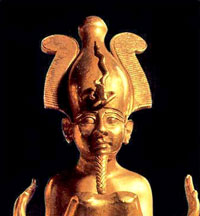 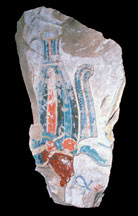 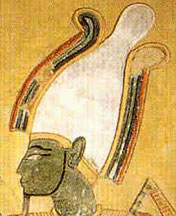
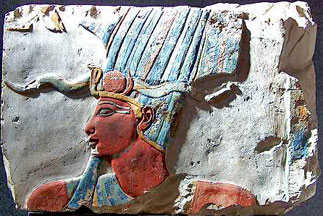
In several reliefs of the Seti I Temple
Osiris was depicted wearing
the Atef crown, which seemed to stand about two feet high.
According
to the Ancient Egyptian
Book of the Dead, it had been given to him
by Ra:
'But on the very first day that he wore it Osiris had much
suffering in his head, and when Ra returned in the evening he found
Osiris with his head angry and swollen from the heat of the Atef
crown. Then Ra proceeded to let out the pus and the blood.'8
All this was stated in a matter-of-fact way, but
- when you stopped to
think about it - what kind of crown was it that radiated heat and
caused the skin to haemorrhage and break out in pustulant sores?
6 Traveller's Key to Ancient Egypt, p. 386.
7 The Encyclopaedia of
Ancient Egypt, p. 59.
8
Chapter 175 of the Ancient Egyptian Book of
the Dead, cited in Myth and Symbol in Ancient Egypt, p. 137.
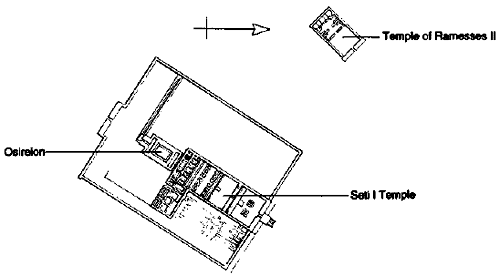
Abydos.
Seventeen centuries of kings
I walked on into the deeper darkness, eventually finding my way to
the Gallery of the Kings. It led off from the eastern edge of the
inner Hypostyle Hall about 200 feet from the entrance to the temple.
To pass through the Gallery was to pass through time itself. On the
wall to my left was a list of 120 of the gods of Ancient Egypt,
together with the names of their principal sanctuaries. On my right,
covering an area of perhaps ten feet by six feet, were the names of
the 76 pharaohs who had preceded Seti I to the throne; each name was
carved in hieroglyphs inside an oval cartouche.
This tableau was known as the 'Abydos King List'.
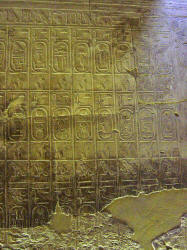
Glowing with colours of molten gold, it was designed to be read from left to
right and was divided into five vertical and three horizontal
registers. It covered a grand expanse of almost 1700 years,
beginning around 3000 BC with the reign of Menes, first king of the
First Dynasty, and ending with Seti's own reign around 1300 BC. At
the extreme left stood two figures exquisitely carved in high
relief: Seti and his young son, the future Ramesses II.
Hypogeum
Belonging to the same class of historical documents as the
Turin
Papyrus and the Palermo Stone, the list spoke eloquently of the
continuity of tradition.
An inherent part of that tradition, was the
belief or memory of a First Time, long, long ago, when the gods had
ruled in Egypt.
|
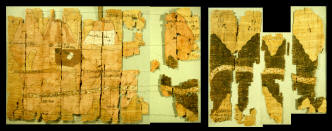
Left half of
the Turin papyrus map |
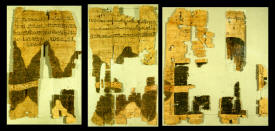
Right half
of the Turin papyrus map |
|
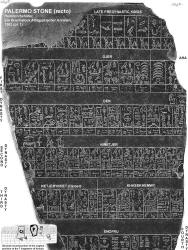
Palermo
Stone |
Principal among those gods was Osiris, and it was
therefore appropriate that the Gallery of the Kings should provide
access to a second corridor, leading to the rear of the temple where
a marvelous building was located - one associated with Osiris from
the beginning of written records in Egypt9 and described by the
Greek geographer Strabo (who visited Abydos in the first century BC)
as 'a remarkable structure built of solid stone... [containing] a
spring which lies at a great depth, so that one descends to it down
vaulted galleries made of monoliths of surpassing size and
workmanship.
There is a canal leading to the place
from the great river ...'10
A few hundred years after Strabo's visit, when the religion of
Ancient Egypt had been supplanted by the new cult of Christianity,
the silt of the river and the sands of the desert began to drift
into the Osirieon, filling it foot by foot, century by century,
until its upright monoliths and huge lintels were buried and
forgotten.
And so it remained, out of sight and out of mind, until
the beginning of the twentieth century, when the archaeologists
Flinders Petrie and Margaret Murray began excavations. In their 1903
season of digging they uncovered parts of a hall and passageway,
lying in the desert about 200 feet south-west of the Seti I Temple
and built in the recognizable architectural style of the Nineteenth
Dynasty.
However, sandwiched between these remains and the rear of
the Temple, they also found unmistakable signs that 'a large
underground building' lay concealed.11
'This hypogeum', wrote
Margaret Murray, 'appears to Professor Petrie to be the place that Strabo mentions, usually called Strabo's
Well.'12
This was good
guesswork on the part of Petrie and Murray.
Shortage of cash,
however, meant that their theory of a buried building was not tested
until the digging season of 1912-13. Then, under the direction of
Professor Naville of the Egypt Exploration Fund, a long transverse
chamber was cleared, at the end of which, to the north-east, was
found a massive stone gateway made up of cyclopean blocks of granite
and sandstone.
The next season, 1913-14, Naville and his team returned with 600
local helpers and diligently cleared the whole of the huge
underground building:
What we discovered [Naville wrote] is a gigantic construction of
about 100 feet in length and 60 in width, built with the most
enormous stones that may be seen in Egypt. In the four sides of the
enclosure walls are cells, 17 in number, of the height of a man and
without ornamentation of any kind.
The building itself is divided
into three naves, the middle one being wider than those of the
sides; the division is produced by two colonnades made of huge
granite monoliths supporting architraves of equal size.13
9
See Henry Frankfort, The Cenotaph of Seti I at Abydos, 39th Memoir
of the Egypt Exploration Society, London, 1933, p. 25.
10 The
Geography of Strabo, volume VIII, pp. 111-13.
11
Margaret A. Murray, The Osireion at Abydos, Egyptian Research
Account, ninth year (1903), Bernard Quaritch, London, 1904, p. 2.
12
Ibid.
13 The Times, London, 17 March 1914.
Naville commented with some astonishment on one block he measured in
the corner of the building's northern nave, a block more than
twenty-five
feet long.14 Equally surprising was the fact that the cells cut into
the enclosure walls had no floors, but turned out, as the
excavations went deeper, to be filled with increasingly moist sand
and earth:
The cells are connected by a narrow ledge between two and three feet
wide; there is a ledge also on the opposite side of the nave, but no
floor at all, and in digging to a depth of 12 feet we reached
infiltrated water. Even below the great gateway there is no floor,
and when there was water in front of it the cells were probably
reached with a small boat.15
14 Ibid.
15 Ibid.
The most ancient stone building in Egypt
Water, water, everywhere - this seemed to be the theme of the
Osireion, which lay at the bottom of the huge crater Naville and his
men had excavated in 1914.
It was positioned some 50 feet below the
level of the floor of the Seti I Temple, almost flush with the
water-table, and was approached by a modern stairway curving down to
the south-east. Having descended this stairway, I passed under the
hulking lintel slabs of the great gateway Naville (and Strabo) had
described and crossed a narrow wooden footbridge - again modern - which
brought me to a large sandstone plinth.
Measuring about 80 feet in length by 40 in width, this plinth was
composed of enormous paving blocks and was entirely surrounded by
water. Two pools, one rectangular and the other square, had been cut
into the plinth along the centre of its long axis and at either end
stairways led down to a depth of about 12 feet below the water
level.
The plinth also supported the two massive colonnades
Naville
mentioned in his report, each of which consisted of five chunky
rose-coloured granite monoliths about eight feet square by 12 feet
high and weighing, on average, around 100 tons.16 The tops of these
huge columns were spanned by granite lintels and there was evidence
that the whole building had once been roofed over with a series of
even larger monolithic slabs.17
16 Traveller's Key to Ancient Egypt, p. 391. 17 The Cenotaph of Seti
I at Abydos, p. 18.
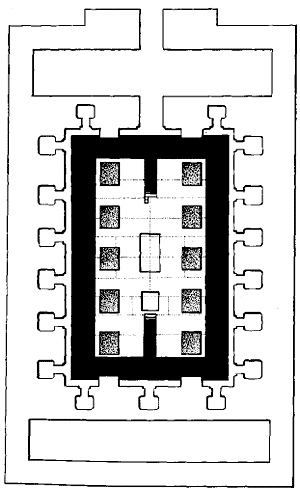
Plan of the Osireion.
To get a proper understanding of the structure of the
Osireion, I
found it helpful to raise myself directly above it in my mind's eye,
so that I could look down on it.
This exercise was assisted by the
absence of the original roof which made it easier to envisage the
whole edifice in plan. Also helpful was the fact that water had now
seeped up to fill all of the building's pools, cells and channels to
a depth of a few inches below the lip of the central plinth, as the
original designers had apparently intended it should.18
Looking down in this manner, it was immediately apparent that the
plinth formed a rectangular island, surrounded on all four sides by
a water-filled moat about 10 feet wide.
The moat was contained by an
immense, rectangular enclosure wall, no less than 20 feet thick,19
made of very large blocks of red sandstone disposed in polygonal
jigsaw-puzzle patterns. Into the huge thickness of this wall were
set the 17 cells mentioned in Naville's report. Six lay to the east,
six to the west, two to the south and three to the north.
Off the
central of the three northern cells lay a long transverse chamber,
roofed with and composed of limestone. A similar transverse chamber,
also of limestone but no longer with an intact roof, lay immediately
south of the great gateway.
Finally, the whole structure was
enclosed within an outer wall of limestone, thus completing a
sequence of inter-nested rectangles, i.e., from the outside in,
wall, wall, moat, plinth.
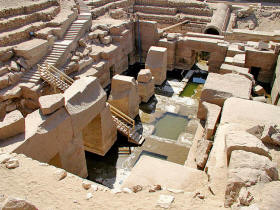 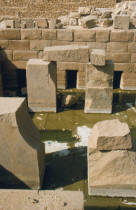
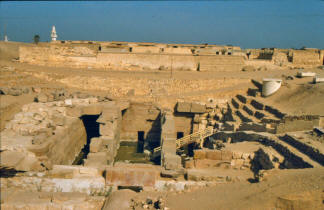
Another notable and outstandingly unusual feature of the
Osireion
was that it was not even approximately aligned to the cardinal
points.
Instead, like the Way of the Dead at Teotihuacan in Mexico,
it was oriented to the east of due north. Since Ancient Egypt had
been a civilization that could and normally did achieve precise
alignments for its buildings, it seemed to me improbable that this
apparently skewed orientation was accidental. Moreover, although 50
feet higher, the Seti I Temple was oriented along exactly the same
axis - and again not by accident.
The question was: which was the
older building? Had the axis of the Osireion been predetermined by
the axis of the Temple or vice versa? This, it turned out, was an
issue over which considerable controversy, now long forgotten, had
once raged.
In a debate which had many connections with that
surrounding the Sphinx and the Valley Temple at Giza, eminent
archaeologists had initially argued that the Osireion was a building
of truly immense antiquity, a view expressed by Professor Naville in
the London Times of 17 March 1914:
This monument raises several important questions. As to its date,
its great similarity with the Temple of the Sphinx [as the Valley
Temple was then known] shows it to be of the same epoch when
building was made with enormous stones without any ornament. This is
characteristic of the oldest architecture in Egypt. I should even
say that we may call it the most ancient stone building in Egypt.20
18 Ibid., p. 28-9.
19
E. Naville, 'Excavations at Abydos: The Great Pool and the Tomb of
Osiris', Journal of Egyptian Archaeology, volume I, 1914, p. 160.
20
The Times, London, 17 March 1914.
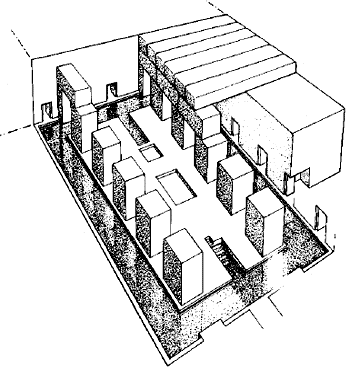
Reconstruction of the Osireion.
Describing himself as overawed by the 'grandeur and stern
simplicity' of the monument's central hall, with its remarkable
granite monoliths, and by 'the power of those ancients who could
bring from a distance and move such gigantic blocks', Naville made a
suggestion concerning the function the Osireion might originally
have been intended to serve:
'Evidently this huge construction was a
large reservoir where water was stored during the high Nile ... It
is curious that what we may consider as a beginning in architecture
is neither a temple nor a tomb, but a gigantic pool, a waterwork
...21
21 Ibid.
Curious indeed, and well worth investigating further; something
Naville hoped to do the following season. Unfortunately, the First
World War intervened and no archaeology could be undertaken in Egypt
for several years.
As a result, it was not until 1925 that the Egypt
Exploration Fund was able to send out another mission, which was led
not by Naville but by a young Egyptologist named Henry Frankfort.
Frankfort's facts
Later to enjoy great prestige and influence as professor of
Pre-Classical Antiquity at the University of London, Frankfort spent
several consecutive digging seasons re-clearing and thoroughly
excavating the Osireion between 1925 and 1930.
During the course of
this work he made discoveries which, so far as he was concerned,
'settled the date of the building':
1 - A granite dovetail in position at the top of the southern side of
the
main entrance to the central hall, which was inscribed with the
cartouche of Seti I.
2 - A similar dovetail in position inside the eastern wall of the
central hall.
3 - Astronomical scenes and inscriptions by Seti I carved in relief on
the ceiling of the northern transverse chamber.
4 - The remains of similar scenes in the southern transverse chamber.
5 - An ostracon (piece of broken potsherd) found in the entrance
passage and bearing the legend 'Seti is serviceable to Osiris'.22
The reader will recall the lemming behaviour which led to a dramatic
change of scholarly opinion about the antiquity of the Sphinx and
the Valley Temple (due to the discovery of a few statues and a
single cartouche which seemed to imply some sort of connection with
Khafre).
Frankfort's finds at Abydos caused a similar volte-face
over the antiquity of the Osireion. In 1914 it was 'the most ancient
stone building in Egypt'. By 1933, it had been beamed forward in
time to the reign of Seti I - around 1300 BC - whose cenotaph it was
now believed to be.23
22 The Cenotaph of Seti I at Abydos, pp. 4, 25, 68-80.
23 Ibid., in
general.
Within a decade, the standard Egyptological texts began to print the
attribution to Seti I as though it were a fact, verifiable by
experience or observation. It is not a fact, however, merely
Frankfort's interpretation of the evidence he had found.
The only facts are that certain inscriptions and decorations left by
Seti appear in an otherwise completely anonymous structure. One
plausible explanation is that the structure must have been built by
Seti, as Frankfort proposed. The other possibility is that the
half-hearted and scanty decorations, cartouches and inscriptions
found by Frankfort could have been placed in the Osireion as part of
a renovation and repair operation undertaken in Seti's time
(implying that the structure was by then ancient, as Naville and
others had proposed).
What are the merits of these mutually contradictory propositions
which
identify the Osireion as (a) the oldest building in Egypt, and (b) a
relatively late New Kingdom structure?
Proposition (b) - that it is the
cenotaph of Seti I - is the only
attribution accepted by Egyptologists. On close inspection, however,
it rests on the circumstantial evidence of the cartouches and
inscriptions which prove nothing. Indeed part of this evidence
appears to contradict Frankfort's case. The ostracon bearing the
legend 'Seti is serviceable to Osiris' sounds less like praise for
the works of an original builder than praise for a restorer who had
renovated, and perhaps added to, an ancient structure identified
with the First Time god Osiris.
And another awkward little matter
has also been overlooked. The south and north 'transverse chambers',
which contain Seti I's detailed decorations and inscriptions, lie
outside the twenty-foot-thick enclosure wall which so adamantly
defines the huge, undecorated megalithic core of the building. This
had raised the reasonable suspicion in Naville's mind (though
Frankfort chose to ignore it) that the two chambers concerned were
'not contemporaneous with the rest of the building' but had been
added much later during the reign of Seti I, 'probably when he built
his own temple'.24
To cut a long story short, therefore, everything about proposition
(b) is based in one way or another on Frankfort's not necessarily
infallible interpretation of various bits and pieces of possibly
intrusive evidence.
Proposition (a) - that the core edifice of
the Osireion had been built
millennia before Seti's time - rests on the nature of the architecture
itself. As Naville observed, the Osireion's similarity to the Valley
Temple at Giza 'showed it to be of the same epoch when building was
made with enormous stones'.
Likewise, until the end of her life,
Margaret Murray remained convinced that the Osireion was not a
cenotaph at all (least of all Seti's). She said,
It was made for the celebration of the mysteries of Osiris, and so
far is unique among all the surviving buildings of Egypt. It is
clearly early, for the great blocks of which it is built are of the
style of the Old Kingdom; the simplicity of the actual building also
points to it being of that early date. The decoration was added by Seti I, who in that way laid claim to the building, but seeing how
often a Pharaoh claimed the work of his predecessors by putting his
name on it, this fact does not carry much weight. It is the style of
the building, the type of the masonry, the tooling of the stone, and
not the name of a king, which date a building in Egypt.25
This was an admonition Frankfort might well have paid more attention
to, for as he bemusedly observed of his 'cenotaph', 'It has to be
admitted that no similar building is known from the Nineteenth
Dynasty.'26
24 'Excavations at Abydos', pp. 164-5.
25 The Splendour that was
Egypt, pp. 160-1.
26 The Cenotaph of Seti I at Abydos, p. 23.
Indeed it is not just a matter of the Nineteenth Dynasty. Apart from
the Valley Temple and other Cyclopean edifices on the Giza plateau,
no other building remotely resembling the Osireion is known from any
other
epoch of Egypt's long history. This handful of supposedly Old
Kingdom structures, built out of giant megaliths, seems to belong in
a unique category.
They resemble one another much more than they
resemble any other known style of architecture and in all cases
there are question-marks over their identity.
-
Isn't this precisely what one would expect of buildings not erected
by any historical pharaoh but dating back to prehistoric times?
-
Doesn't it make sense of the mysterious way in which the Sphinx and
the Valley Temple, and now the Osireion as well, seem to have become
vaguely connected with the names of particular pharaohs (Khafre and
Seti I), without ever yielding a single piece of evidence that
clearly and unequivocally proves those pharaohs built the structures
concerned?
-
Aren't the tenuous links much more indicative of the work
of restorers seeking to attach themselves to ancient and venerable
monuments than of the original architects of those monuments - whoever
they might have been and in whatever epoch they might have lived?
Setting sail across seas of sand and time
Before leaving Abydos, there was one other puzzle that I wanted to
remind myself of. It lay buried in the desert, about a kilometer
north-west of the Osireion, across sands littered with the rolling,
cluttered tumuli of ancient graveyards.
Out among these cemeteries, many of which dated back to early
dynastic and pre-dynastic times, the jackal gods Anubis and
Upuaut
had traditionally reigned supreme. Openers of the way, guardians of
the spirits of the dead, I knew that they had played a central role
in the mysteries of Osiris that had been enacted each year at
Abydos - apparently throughout the span of Ancient Egyptian history.
It seemed to me that there was a sense in which they guarded the
mysteries still.
For what was the Osireion if was not a huge,
unsolved mystery that deserved closer scrutiny than it has received
from the scholars whose job it is to look into these matters? And
what was the burial in the desert of twelve high-prowed, seagoing
ships if not also a mystery that cried out, loudly, for solution?
It was the burial place of those ships I was now crossing the
cemeteries of the jackal gods to see:
The Guardian, London, 21
December 1991:
A fleet of 5000-year-old royal ships has been found
buried eight miles from the Nile. American and Egyptian
archaeologists discovered the 12 large wooden boats at Abydos ...
Experts said the boats - which are 50 to 60 feet long - are about 5000
years old, making them Egypt's earliest royal ships and among the
earliest boats found anywhere ...
The experts say the ships,
discovered in September, were probably meant for burial so the souls
of the pharaohs could be transported on them. 'We never expected to
find such a fleet, especially so far from the Nile,' said David
O'Connor, the expedition leader and curator of the Egyptian Section
of the University Museum of
the University of Pennsylvania ...27
The boats were buried in the shadow of a gigantic mud-brick
enclosure, thought to have been the mortuary temple of a Second
Dynasty pharaoh named Khasekhemwy, who had ruled Egypt in the
twenty-seventh century BC.28
O'Connor, however, was certain that
they were not associated directly with Khasekhemwy but rather with
the nearby (and largely ruined) 'funerary-cult enclosure built for
Pharaoh Djer early in Dynasty I. The boat graves are not likely to
be earlier than this and may in fact have been built for Djer, but
this remains to be proven.'29
A sudden strong gust of wind blew across the desert, scattering
sheets of sand.
I took refuge for a while in the lee of the looming
walls of the Khasekhemwy enclosure, close to the point where the
University of Pennsylvania archaeologists had, for legitimate
security reasons, reburied the twelve mysterious boats they had
stumbled on in 1991. They had hoped to return in 1992 to continue
the excavations, but there had been various hitches and, in 1993,
the dig was still being postponed.
In the course of my research O'Connor had sent me the official
report of the 1991 season,30 mentioning in passing that some of the
boats might have been as much as 72 feet in length.31
He also noted
that the boat-shaped brick graves in which they were enclosed, which
would have risen well above the level of the surrounding desert in
early dynastic times, must have produced quite an extraordinary
effect when they were new:
Each grave had originally been thickly coated with mud plaster and
whitewash so the impression would have been of twelve (or more) huge
'boats' moored out in the desert, gleaming brilliantly in the
Egyptian sun.
The notion of their being moored was taken so
seriously that an irregularly shaped small boulder was found placed
near the 'prow' or 'stern' of several boat graves. These boulders
could not have been there naturally or by accident; their placement
seems deliberate, not random. We can think of them as 'anchors'
intended to help 'moor' the boats.32
Like the 140-foot ocean-going vessel found buried beside the Great
Pyramid at Giza (see Chapter Thirty-three), one thing was
immediately clear about the Abydos boats - they were of an advanced
design capable of riding out the most powerful waves and the worst
weather of the open seas.
According to Cheryl Haldane, a nautical
archaeologist at Texas A-and-M University, they showed 'a high
degree of technology combined with grace'.33
27 Guardian, London, 21 December 1991.
28
David O'Connor, 'Boat Graves and Pyramid Origins', in Expedition,
volume 33, No. 3, 1991, p. 7ff.
29 Ibid., pp. 9-10.
30 Sent to me by
fax 27 January 1993.
31 David O'Connor,
'Boat Graves and Pyramid
Origins', p. 12.
32 Ibid., p. 11-12.
33 Guardian, 21 December 1991.
Exactly as was the case
with the Pyramid boat, therefore (but at least 500 years earlier)
the Abydos fleet seemed to indicate that a people able to draw upon
the accumulated experiences of a long tradition
of seafaring had been present in Egypt from the very beginning of
its 3000 year history.
Moreover I knew that the earliest wall
paintings found in the Nile Valley, dating back perhaps as much as
1500 years before the burial of the Abydos fleet (to around 4500 BC)
showed the same long, sleek, high-prowed vessels in action.34
Could an experienced race of ancient seafarers have become involved
with the indigenous inhabitants of the Nile Valley at some
indeterminate period before the official beginning of history at
around 3000 BC? Wouldn't this explain Egypt's curious and
paradoxical - but nonetheless enduring - obsession with ships in the
desert (and references to what sounded like sophisticated ships in
the Pyramid Texts, including one said to have been more than 2000
feet long)?35
34 See Cairo Museum, Gallery 54, wall-painting of ships from Badarian period c. 4500 BC.
35
The Ancient Egyptian Pyramid Texts, p. 192, Utt. 519: 'O Morning
Star, Horus of the Netherworld ... you having a soul and appearing
in front of your boat of 770 cubits ... Take me with you in the
cabin of your boat.'
In raising these conjectures, I did not doubt that religious
symbolism had existed in Ancient Egypt in which, as scholars
endlessly pointed out, ships had been designated as vessels for the
pharaoh's soul.
Nevertheless that symbolism did not solve the
problem posed by the high level of technological achievement of the
buried ships; such evolved and sophisticated designs called for a
long period of development.
Wasn't it worth looking into the
possibility - even if only to rule it out - that the Giza and Abydos
vessels could have been parts of a cultural legacy, not of a
land-loving, riverside-dwelling, agricultural people like the
indigenous Ancient Egyptians but of an advanced seafaring nation?
Such seafarers could have been expected to be navigators who would
have known how to set a course by the stars and who would perhaps
also have developed the skills necessary to draw up accurate maps
and charts of the oceans they had traversed.
Might they also have been architects and stonemasons whose
characteristic medium had been polygonal, megalithic blocks like
those of the Valley Temple and the Osireion?
And might they have been associated in some way with the legendary
gods of the First Time, said to have brought to Egypt not only
civilization and astronomy and architecture, and the knowledge of
mathematics and writing, but a host of other useful skills and
gifts, by far the most notable and the most significant of which had
been the gift of agriculture?
There is evidence of an astonishingly early period of agricultural
advance and experimentation in the Nile Valley at about the end of
the last Ice Age in the northern hemisphere.
The characteristics of
this great
Egyptian 'leap forward' suggest that it could only have resulted
from an influx of new ideas from some as yet unidentified source.
Back to
Contents
or
Continue to Chapter 46
→
|














